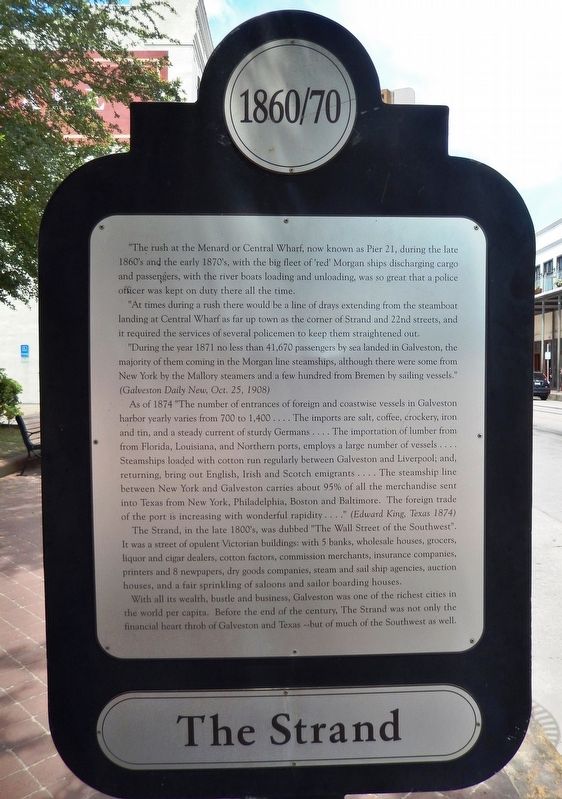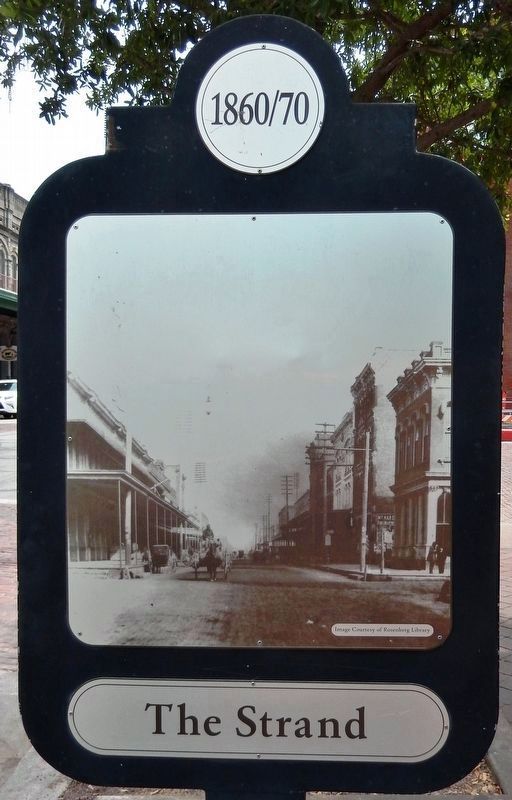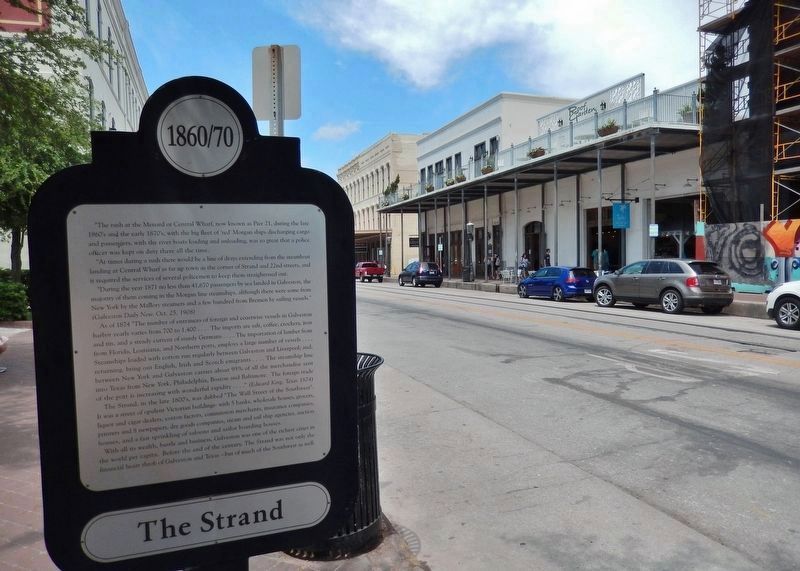Galveston in Galveston County, Texas — The American South (West South Central)
The Strand
1860/70
"At times during a rush there would be a line of drays extending from the steamboat landing at Central Wharf as far up town as the corner of Strand and 22nd streets, and it required the services of several policemen to keep them straightened out.
"During the year 1871 no less than 41,670 passengers by sea landed in Galveston, the majority of them coming in the Morgan line steamships, although there were some from New York by the Mallory steamers and a few hundred from Bremen by sailing vessels." (Galveston Daily News, Oct. 25, 1908)
As of 1874 "The number of entrances of foreign and coastwise vessels in Galveston harbor yearly varies from 700 to 1,400… The imports are salt, coffee, crockery, iron and tin, and a steady current of sturdy Germans.... The importation of lumber from Florida, Louisiana, and Northern ports, employs a large number of vessels.... Steamships loaded with cotton run regularly between Galveston and Liverpool; and, returning, bring out English, Irish and Scotch emigrants… The steamship line between New York and Galveston carries about 95% of all the merchandise sent into Texas from New York, Philadelphia, Boston and Baltimore. The foreign trade of the port is increasing with wonderful rapidity...." (Edward King, Texas 1874)
The Strand, in the late 1800's, was dubbed "The Wall Street of the Southwest.” It was a street of opulent Victorian buildings: with 5 banks, wholesale houses, grocers, liquor and cigar dealers, cotton factors, commission merchants, insurance companies, printers and 8 newspapers, dry goods companies, steam and sail ship agencies, auction houses, and a fair sprinkling of saloons and sailor boarding houses.
With all its wealth, bustle and business, Galveston was one of the richest cities in the world per capita. Before the end of the century, The Strand was not only the financial heart throb of Galveston and Texas -- but of much of the Southwest as well.
Topics. This historical marker is listed in these topic lists: Industry & Commerce • Settlements & Settlers • Waterways & Vessels. A significant historical year for this entry is 1860.
Location. 29° 18.442′ N, 94° 47.603′ W. Marker is in Galveston, Texas, in Galveston County. Marker is on Strand Street west of Kempner Street, on the right when traveling east. Touch for map. Marker is at or near this postal address: 2201 Strand Street, Galveston TX 77550, United States of America. Touch for directions.
Other nearby markers.
At least 8 other markers are within walking distance of this marker. Juneteenth (a few steps from this marker); The First National Bank of Galveston (within shouting distance of this marker); Old Galveston Square (within shouting distance of this marker); The Stewart Building (within shouting distance of this marker); Mallory-Produce Building (within shouting distance of this marker); Central Wharf (about 300 feet away, measured in a direct line); W. P. Ballinger Law Firm (about 300 feet away); Samson Heidenheimer Building (about 400 feet away). Touch for a list and map of all markers in Galveston.
More about this marker. Marker consists of two large laser-printed metal plaques, one with text and one with an historic photo, mounted vertically at eye-level, on either side of a five-foot tall post.
Regarding The Strand. National Register of Historic Places #70000748 (1970), and National Historic Landmark (1976)
Also see . . .
1. Strand Historic District. The original plat of Galveston, drawn in the late 1830s, includes Avenue B. The name "strand" for Avenue B was coined by a German immigrant named Michael William Shaw who opened a jewelry store on the corner of 23rd and Avenue B. Shaw changed the name of the street on his stationery
to "Strand", thinking that the name (named after a street in London) would have higher-class connotations for his jewelry store. He later convinced other owners on the street to change the names they used for the street as well, and the name stuck. (Submitted on February 27, 2019, by Cosmos Mariner of Cape Canaveral, Florida.)
2. National Register of Historic Places Nomination #70000748. The Strand Historic District (Submitted on February 27, 2019, by Cosmos Mariner of Cape Canaveral, Florida.)
Credits. This page was last revised on February 28, 2019. It was originally submitted on February 27, 2019, by Cosmos Mariner of Cape Canaveral, Florida. This page has been viewed 240 times since then and 16 times this year. Photos: 1, 2, 3, 4. submitted on February 27, 2019, by Cosmos Mariner of Cape Canaveral, Florida. • Bernard Fisher was the editor who published this page.



